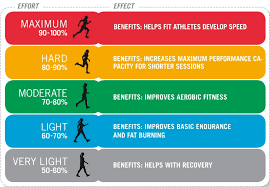Over the past couple of months, we’ve been diving into heart rates, so today, let’s break down the five heart rate zones and what they mean for your training.
Before we get started, it’s important to know two key numbers:
✅ Resting Heart Rate (RHR): The number of beats per minute while at complete rest, best measured in the morning after a good night’s sleep. If you wear a fitness watch, it likely tracks this for you.
✅ Maximum Heart Rate (MHR): An estimate of your highest possible heart rate. One of the most accurate formulas for adults and middle-aged individuals is the Tanaka Formula: MHR = 207 – (0.7 x Age)
Heart Rate Zones Breakdown
Zone 1: Very Light (50-60% of MHR) – Recovery & Warm-Up
Intensity: Very easy, relaxed breathing, can hold a conversation.
Training Effect: Enhances recovery, improves circulation, and promotes overall health.
Best for: Warm-ups, cool-downs, active recovery, and beginners.
Zone 2: Light (60-70% of MHR) – Fat Burning & Endurance
Intensity: Comfortable, steady breathing, slightly deeper than at rest.
Training Effect: Builds aerobic capacity, endurance, and enhances fat metabolism.
Best for: Long, steady-state cardio like walking, light jogging, and cycling.
Zone 3: Moderate (70-80% of MHR) – Aerobic Fitness
Intensity: Breathing is heavier, talking becomes harder.
Training Effect: Boosts cardiovascular fitness and stamina.
Best for: Tempo runs, moderate-intensity workouts, and general fitness improvement.
Zone 4: Hard (80-90% of MHR) – Anaerobic Threshold
Intensity: Heavy breathing, conversation is difficult.
Training Effect: Increases speed, power, and anaerobic endurance.
Best for: High-intensity intervals, threshold training, and race preparation.
Zone 5: Maximum (90-100% of MHR) – Peak Performance
Intensity: All-out effort, breathless, unsustainable for long periods.
Training Effect: Develops explosive power, speed, and VO₂ max.
Best for: Short sprints, HIIT workouts, and maximal-effort training.
How to Use Heart Rate Zones in Training
✔ For endurance and marathon training: Focus on Zones 2-3.
✔ For speed and power development: Incorporate Zones 4-5 regularly.
✔ For general fitness and fat loss: Mix Zones 2-4 for variety and balanced training.
Understanding heart rate zones can help you train smarter, improve performance, and reach your fitness goals more effectively. Hope this helps you fine-tune your workouts!
Until next week,
Nick and Tom





